![]()
![]()
![]()
Use LEFT and RIGHT arrow keys to navigate between flashcards;
Use UP and DOWN arrow keys to flip the card;
H to show hint;
A reads text to speech;
23 Cards in this Set
- Front
- Back

|
Charlemagne Holding and Orb and a Sword, an illuminated
Manuscript from ca. the 9th century Carolingian Empire Monastery Convent |
|
|
medieval period
|
wwest roman empire 5th century, middle ages , dark age of ignorance, decline & barbarism; renaissance humanists
|
|
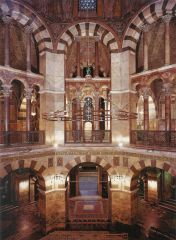
|
*Carolingian, Palace Chapel of Charlemagne,
c. 792-805, Aachen, Germany; emporers private chapel, church of imperial court, place for relics of saints, & after charlemagnes death, the imperial mausoleum, central octagonal plan resembled San Vitale, new architecture: WESTWORK 9monumental entrance block (facade), ambulatory(curving aisle passageway), ringed by gallery (upper story platform) relihion & education/ benedictine monks= "cultural army", followed rule for Monasterie written by St benedict combo of work and prayer, in library & known as ST GALL PLAN |
|
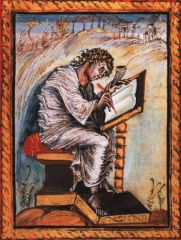
|
*Carolingian, Page with Matthew the
Evangelist, from The Ebbo Gospels, c. 9th century, ink on vellum, gospel book made for archbishop ebbo of reims. |
|
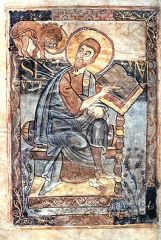
|
Carolingian, Page with Mark the Evangelist,
from The Godescale Evanggelistary, c. 781-3, Ink on vellum |
|
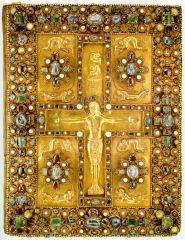
|
*Carolingian, Crucifixion with Angels and
Mourning Figures, cover of the Lindau Gospels, c. 870-80, gold and jewels; richest of the sumptous books (protected w heavy wooden covers that are sometimes sheathed in sheets of pure gold. Crusifixion using repousse technique (pushing or hamering up from the back of a metal panel to make raise); heavenly jerusalem (gems). |
|
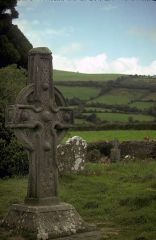
|
Pope Gregory I:
Letter to Abbot Mellitus “Tell Augustine that he should be no means destroy the temples of the gods but rather the idols within those temples. Let him, after he has purified them with holy water, place altars and relics of the saints in them. For, if those temples are well built, they should be converted from the worship of demons to the service of the true God. Thus, seeing that their places of worship are not destroyed, the people will banish error from their hearts and come to places familiar and dear to them in acknowledgement and worship of the true God.” Hiberno-Saxon South Cross, Ireland, c. 8th century, stone |
|

|
Hiberno-Saxon, Purse Cover, from Sutton Hoo, c. 7th century, England, cloisonné
|
|
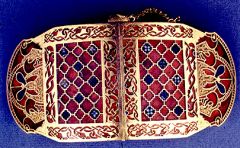
|
*Hiberno-Saxon, Cloak Clasp, from Sutton Hoo, c. 7th century, England, cloisonné(Enamel work in which the different colors are separated by strips of flattened wire placed edgeways on a metal backing.);
|
|

|
Hiberno-Saxon, Cover of the Lindesfarne
Gospels, c. 9th Century, gold and jewels Repoussé, openwork, interlace |
|
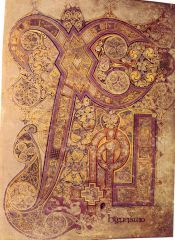
|
*Hiberno-Saxon, Chi Rho Iota Page,
from The Book of Kells, Scotland, c. 800, ink on vellum Initial page; Abbreviatethe word Christi "autem generatio". Matthew 1:18. shows christ's fist appearance within a Gospel book that contains the 4 biblical accounts of his life; evokes his presence on the altar of the monastery church where the book was once housed. |
|
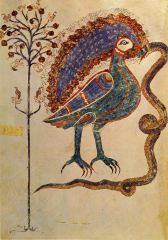
|
Mozarabic, Emeterius and Ende, Battle of
the Bird and Serpent from Beatus, Spain, c. 975, ink on parchment |
|

|
*Maius, Seven-Headed Dragon and Woman Clothed with the Sun, from the Morgan Beatus, c. 940-5, tempera on vellum ; based on biblical text of Apocalypse, snake threatens "woman clothed with the sun" at top left. he sweeps a third of heaven's stars toward the earth while the womans male child appears before the throne of God with his tail. triumph of Church over its enemies.
|
|
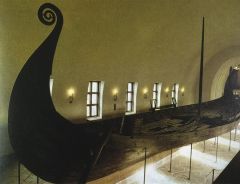
|
Viking, Queen’s Ship, from Oseberg, Norway, c. 815-20, wood
|
|
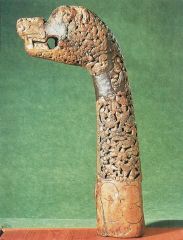
|
Viking, Post, from Osenberg ship burial,
c. 815-30, wood |
|
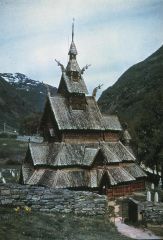
|
*Viking, Borgund Stave Church, Norway, c. 1125-50
ridgepole, wattle-and-daub, thatching; Stave churches named for 4 huge timbers that form their structural core. |
|
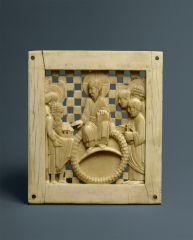
|
Ottonian, Otto I Presenting Magder-
burg Cathedral to Christ, c. 962-68, ivory |
|
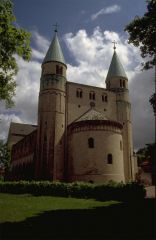
|
*Ottonian, Church of Cyriakus, exterior and nave, Gemrode, Germany, 961-973;
|
|
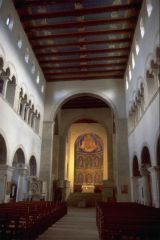
|
*Ottonian, Church of Cyriakus, exterior and nave, Gemrode, Germany, 961-973; founded by Gero. a basilica, w/ nave flanked by side aisles. his widoed daughter is its first Abbess.
|
|
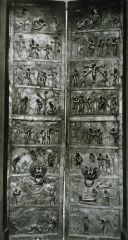
|
*Ottonian, Doors of Bishop Bernward, Abbey Church of St. Michael, Hildesheim, Germany,
1015, bronze; scenes from Hebrew bible(left) & from new testament (right). |
|
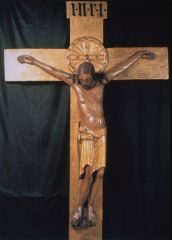
|
Ottonian, Gero Crucifix, from Cologne Cathedral, Germany, c. 970, painted wood
|
|

|
*Ottonian, Christ Washing the Feet of His
Disciples, from Gopels of Otto III, c. 1000 ink on vellum; jesus washed feet of his disciples during their final meals together. Peter on left. classical tradition into a style of stunning epressiveness & narrator power, Romanesque. |
|
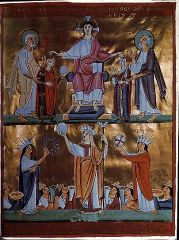
|
Christ Enthroned, example of a late-9th
Century Ottonian manuscript |

